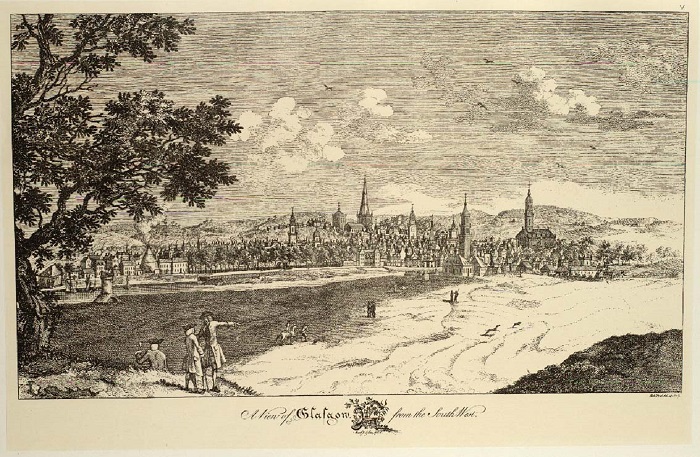Smith at Glasgow
Adam Smith began his studies at the University of Glasgow in 1737, at the young but, for the time not unusual, age of 14 years old.
In the 1700s, the University was already well known and respected, with leaders of the Scottish Enlightenment holding court in the lecture theatres.
In 1737, at the young - but for the time not unusual - age of 14, Smith began his studies at the University of Glasgow. Much like today, the university used a four-year system. However, Smith's exceptional Latin skills granted him entry straight into to second year. At this time, class sizes were very small, with only 200 students in attendance at the entire university.
In the 1700s, the university was already well known and respected, with leaders of the Scottish Enlightenment holding court in the lecture theatres. Lectures were held in the Old College, which sprawled across 26 acres of land on Glasgow’s High Street. The divinity lecturer John Simpson made use of the available green space, even keeping a cow on campus.
Smith the student
Smith studied logic, metaphysics, maths, Newtonian physics, and moral philosophy under the tutelage of some of the leading scholars of the day, including Francis Hutcheson and Robert Simpson. In the afternoons, classes would have been smaller and more intimate, much like the seminars of today. Sadly, we have no record of the essays or coursework written by Smith. In the mornings, Smith would have attended a large lecture with his fellow classmates.
At the time, it was common for students to not officially graduate, and instead end their studies when they felt their education was complete. For this reason, Smith never graduated from the University of Glasgow. In 1740, Smith was awarded the Snell Scholarship, which is still in existence today, and left Glasgow to study at Balliol College, Oxford.
Smith the academic
In 1751, Smith returned to the University of Glasgow as a Professor of Logic, but quickly became a Professor of Moral Philosophy, which better aligned with his interests. In addition to courses in philosophy and jurisprudence, Smith also lectured on literature, language and history. Like many academics at this time, Smith was a polymath, with diverse interests. Moreover, disciplinary boundaries were not as established as they are now.
As a professor, Smith was respected and well-liked by his students. At this time, a professor's salary was directly tied to their students' fees and as his reputation grew, Smith attracted students from all over the world. For instance, students travelled from Switzerland, Russia and the American Colonies to attend his lectures.
Inspired by Francis Hutcheson, Smith adopted a teaching method which involved pacing up and down the rows of students. However, he quickly found he preferred to stand by his lectern and speak from his notes from the front of the class, finding confidence in his own lecturing style.
Smith was known to dislike students who took copious lecture notes, or ‘scribblers’ as he called them, and encouraged his students to listen and reflect on the lecture’s content instead. Smith's 'scribblers' sometimes used their lecture notes to poke fun at their lecturer with doodles.
In addition to their professorial responsibilities, staff were also expected to undertake significant administrative roles to compensate for the small faculty, including sitting on various committees. From 1758 to 1760, Smith acted as "Quaestor", making him responsible for purchasing books for the library. Today, the University Library still holds several of Smith’s purchases, such as a copy of Diderot’s Encyclopédie. Smith also assumed the role of Dean of Faculty between 1760 and 1762, making him responsible for the recruitment, appointment, and retention of academic staff. During this time Smith also acted as "Praeses" who presided over university meetings when the Rector and the official Vice Rector were unavailable. Smith was promoted to Vice Rector in 1763.
Smith was also an active member of the broader intellectual community in Glasgow, taking part in lively discourse at "Town and Gown" exchanges and was a member of a number of literary societies, some of whom still exist today. These debates with his respected contemporaries and businessmen influenced the development of Smith’s best-known work, the Wealth of Nations.
Though Smith led a very busy academic life and held many responsibilities while at Glasgow, he also made time to write and publish the first edition of The Theory of Moral Sentiments in 1759, developing upon the principles and concepts explored in his lectures.
His final connection with Glasgow University came in 1787 when he assumed the prominent position of Rector in 1787. Though this position was largely ceremonial, Smith took the role seriously, ensuring that he kept up to date with meeting minutes. In a letter of thanks for the honour he wrote that remembered his professorial days at Glasgow University as "By far the most useful and therefore as by far the happiest and most honourable period of my life."
Image credit: A facsimile of an engraving showing 'A View of Glasgow from the South west' by Robert Paul, 1764. Source: University of Glasgow Sp Coll Bh13-x.7

Image credit: A facsimile of an engraving showing 'A View of Glasgow from the South west' by Robert Paul, 1764. Source: University of Glasgow Sp Coll Bh13-x.7
"By far the most useful and therefore as by far the happiest and most honourable period of my life."

